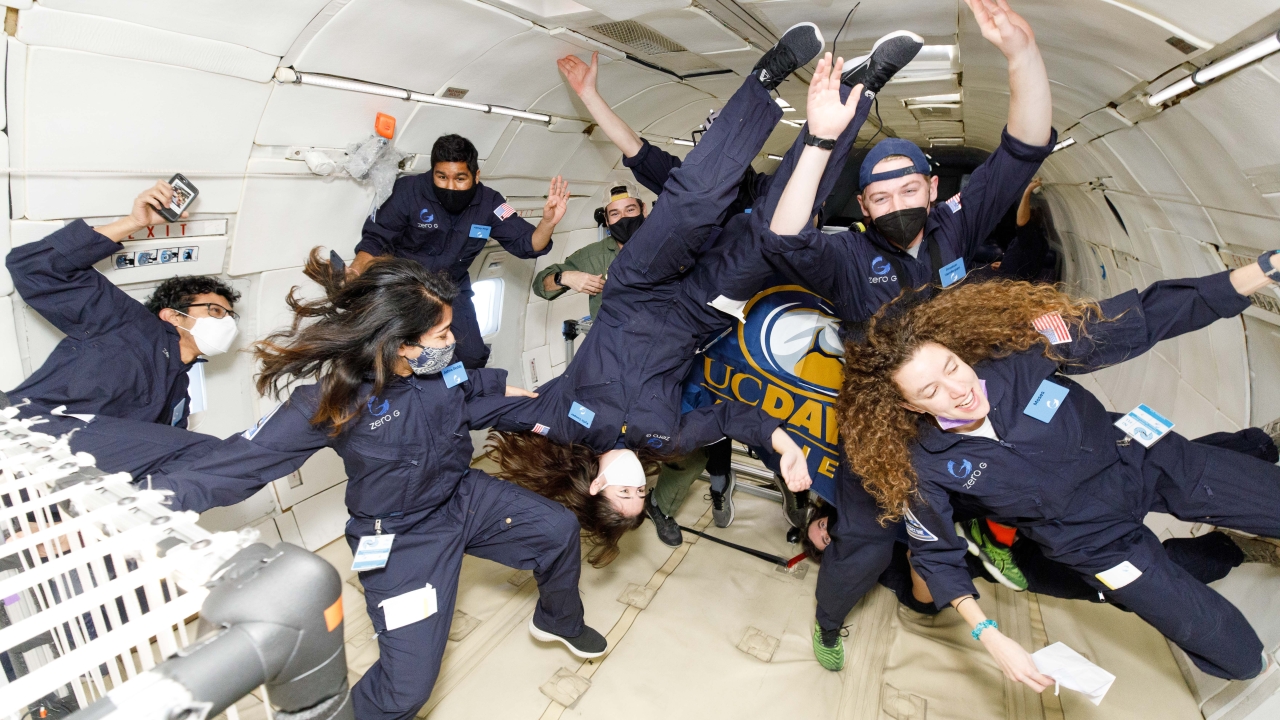
(Dominic Alessandro Dal Porto/UC Davis)
One Small Step: UC Davis Students Fly, Run Experiments in Zero Gravity
Nine mechanical and aerospace engineering students from two research teams at UC Davis experienced zero gravity this December as they successfully tested two spaceflight technologies aboard two parabolic flights.
Parabolic flight tests are a key step in making technology space-ready, as it’s the closest thing to a weightless space-like environment on Earth. A plane flies in a series of parabolas starting from level flight, then going steeply upwards at double gravity and back down at a similar angle. In the middle, gravity becomes negligible.
The students say there’s no easy way to describe zero-g. Some called it dream-like, some said it felt like flying or swimming without limits and some compared it to a roller coaster. They can agree that it’s unlike anything they had ever experienced.
“Every time we pushed over the top of the parabola and started floating, I felt like everything I learned about physics went out the door,” said M.S. student Kylie Cooper.
“It’s like dividing by zero,” said M.S. student Andrew Arends. “It’s the removal of one constant in your life—we’re born into gravity, we live in it and it’s ever-present. It makes you realize that it’s only a constant here on Earth.”
A Tale of Two Technologies
The teams, named HDD and CHANGES, are part of Mechanical and Aerospace Engineering Professor and former astronaut Steve Robinson’s lab. The lab researches spaceflight technology ranging from satellites to deep-space human habitats to human/systems engineering.
Parabolic flight has been called the “vomit comet” because the sudden transitions between gravities can cause disorientation and motion sickness. Astronauts face this challenge when going to space, but being sick while having to perform critical flight tasks could jeopardize a mission.
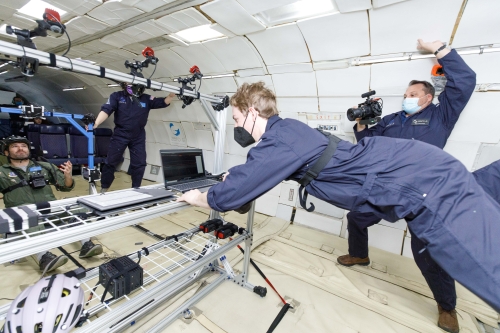
The CHANGES team—M.S. students Casey Miller and Andrew Arends and undergraduates Ruby Houchens and Preston Vanderpan, joined by Ph.D. students Tammer Barkouki and Chris Lorenzen on the flight—is developing a motion-sensing helmet as a solution. The helmet tracks rotational velocity and transitional acceleration on the head and chest and alerts users when they are moving too much. This alert will help users avoid getting sick.
“I’m sure you’ve seen how fluids clump up into little spheres in space, and that includes the vestibular fluid in our ear, which can cause motion sickness,” Arends explained. “Having this simple, non-pharmaceutical method of saying, ‘slow down, you’re gonna get sick’ can help humans adapt to different gravity levels in space and assist people who battle motion sickness on Earth.”
The HDD team—M.S. students Kylie Cooper and Abhay Negi, undergraduates Chris Andrade, Ashna Reddy and Miranda Godinez, joined by M.S. student Janine Moses as operations support—is developing a low-cost reaction wheel for CubeSats. CubeSats are tiny box-shaped satellites that can be equipped with cameras, antennae and sensors. Reaction wheels, which stabilize CubeSats in space by spinning and transferring momentum to turn the satellite or slow its rotation, are essential but expensive and difficult to manufacture reliably.
As undergraduates, Cooper and Negi came across a third option: using a hard drive disk. Like commercial reaction wheels, hard drive disks are precise, robust and can spin at a variable rate. They are also much cheaper and readily available, with modifications so they can spin in two directions. As they developed the idea, talked with professionals and continued their work as M.S. students, Cooper and Negi realized how much of an impact their design could make.
“We already had half of the technology we needed, and it’s a very low-cost alternative to what’s usually thousands or tens of thousands of dollars,” said Cooper.
Preparing for Zero-G
The two teams received grants to fly zero-g in fall 2020, which kicked off a year of preparation. Each zero-g session lasts for 18-20 seconds, which means they needed to spend months designing, rehearsing and refining their experiments to make sure everything was as foolproof as possible.
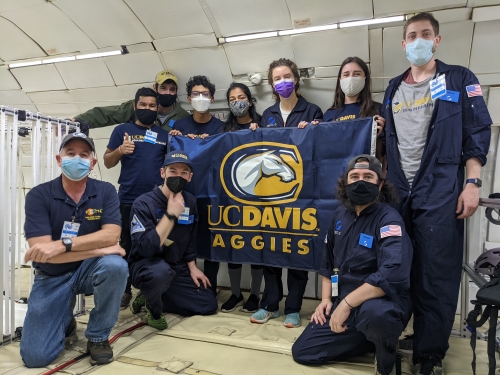
“It’s a very finite amount of time that you get to spend in zero-g, so you really want to maximize your results, and that means there’s a lot you have to prepare for,” said Negi.
The CHANGES experiments involved completing upper-body tasks in zero-g to make sure the helmet’s signals were working and flashed at the correct time. The HDD team built a cage to give their CubeSat a controlled place to fly and then used special laser-engraved markers for each face of the cube and a computer vision system developed by Reddy to track its motion. Preparation was hard work, but the teams developed a fantastic synergy as they worked alongside one another.
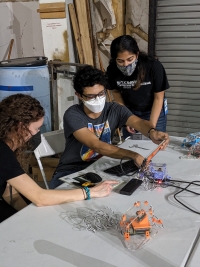
“Our teams are close and we work really well together,” said Cooper. “There were a lot of late nights and we’ve all had our hands in every single part of all the systems. Although everything went well, that’s only because we put in so much extra effort to make sure we could overcome anything that happened to the hardware or the experiment.”
Robinson’s support was the common denominator. Not only could he speak from personal experience about zero-g, but he also brought in experts to share their experiences to help prepare the students. He was also constantly there to encourage and reassure them as they anxiously prepared for the flight. The Engineering Student Design Center (ESDC) staff also played a big role in making sure the teams had the tools, resources and skills they needed to manufacture their parts.
“Winning the Super Bowl”
On each flight, the plane completes 30 parabolas. The first five simulate lunar and then Martian gravity before it dives into zero-g for the final 25. The teams were excited to experience these other gravities and the weird transitions between them, but they say zero-g was totally unique.
“I feel like we learned more in the first five minutes of the zero-g parabolas than we could have prepared for in weeks and months leading up to the flight,” said Moses.
Though weightlessness was disorienting at first, the students soon realized how fun it could be. Arends says he liked finding new ways to look at their experiments—literally. Vanderpan remembers playing around with gravity and watching a hat slowly float in zero-g or drop comically fast at two g’s.
“There’s this steep learning curve, but it becomes this wonderful, majestic experience,” said Arends. “The first time is nerve-wracking—the simplest touch will send you tumbling, and it’s this whole new way of moving your body. By the end, you learn very naturally like a child learning to walk, and you can have a lot of fun with it.”
Robinson warned that it’s rare that everything would work on the first try, and both teams were fixing and fine-tuning their designs up until the night before and even between flights. Despite that, everything went flawlessly. Negi compares it to winning the Super Bowl. When the teams saw their experiments working, they couldn’t help but cheer.
“When you work so hard with such a good team on something for over a year and then see it finally working, it’s really great,” said Cooper. “I’m so proud of our team and I think everyone can say the same thing.”
Though the success was rewarding, the students say the best part was experiencing everything together.
“Even though none of us really know how to describe zero-g, we can all agree that being together and working together as a team is what made the experience so great,” said Andrade.
Ad Astra
The teams became proud Aggies in Ft. Lauderdale and took a piece of history with them—the same UC Davis flag that Robinson flew on the International Space Station. It’s the first time the flag has flown since, and it represents a new era of space research at UC Davis.
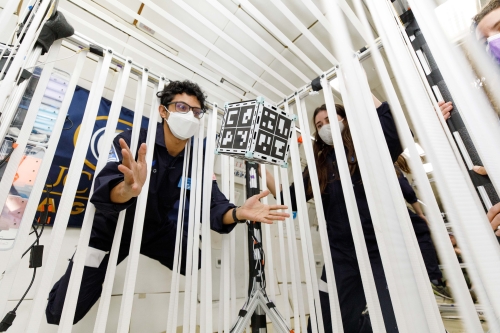
The HDD team’s reaction wheel will go to space on CubeSats twice this year with the UC Davis Space and Satellite Systems club and NASA’s Johnson Space Center, respectively. The teams will also do two more parabolic flights this summer in Santa Maria, CA, where they will bring their technology even closer to operation in space.
The experiments will complete three master’s theses and give all the students experience in zero-g testing, teamwork, experiment design and working under pressure that could help launch their careers. Perhaps most importantly, the teams can pass their knowledge on to the next generation of students to help UC Davis make the giant leap into space.
“Some universities have conducted multiple zero-g flights, and part of their success is passing along those lessons learned from project to project,” said Negi. “I think this is the beginning [of that] for UC Davis.”
This story was featured in the Spring 2022 issue of Engineering Progress.
